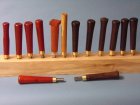In answer to the "how do you align the scraper" question: The reason for "trailing" a flat top scraper is to let the "mini' catches, that they constantly produce, push the tool into air rather than dragging it into the wood. Working slightly below center, and with the handle slightly high on outside of your wood means you don't need the death grip that tries to destroy your elbow. On the inside of a bowl, if you stay at or above center the little drags really do become minimal. The nature of the flat scraper is to try to drag itself forward into the wood, and the downward angle makes this worse, if there is wood to drag into.
The negative rake, primarily a fine finishing tool, both gives you that trailing angle for no effort, but keeps the tool from trying to feed, and lets the tool rest absorb all of the energy of cutting.
Most of us find that we can cut wood out of a bowl a lot easier than scraping, done carefully, and with a truly nicely shaped bowl gouge, you can get awfully close to a finished curve really quickly. Trying to get that last 1 % of perfecting the curve with a gouge is worth a try, but it isn't normally worth the extra time compared to making those few passes with a negative rake scraper.
You have to remember that you are cutting with a tiny burr, and that it isn't going to last very long - regardless of how expensive a steel - so keep your grinder platform set, and expect to return after a very short time.
When that doesn't work, step back and think through the toolbox of tricks you've seen, and remember that there are chunks of wood out there that just don't want to be smooth.
I should credit Stuart Batty, he explains this any time he demonstrates, with diagrams, and advise on steels etc. etc.



